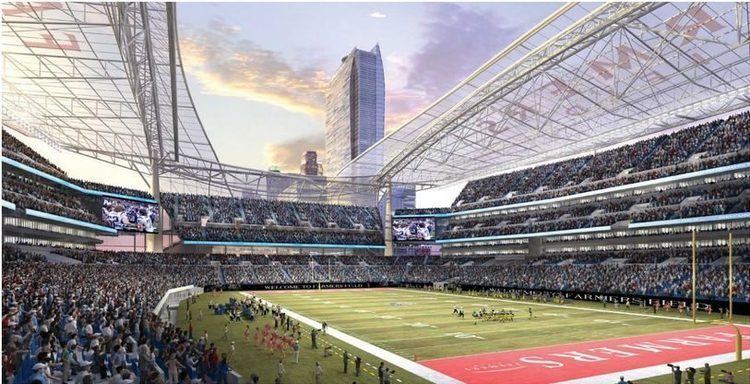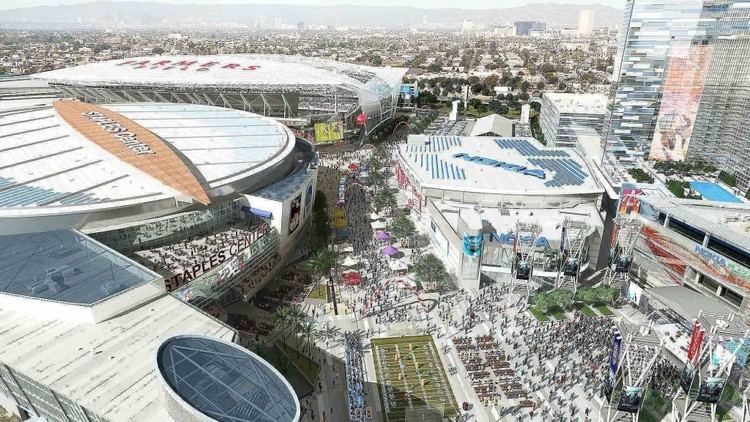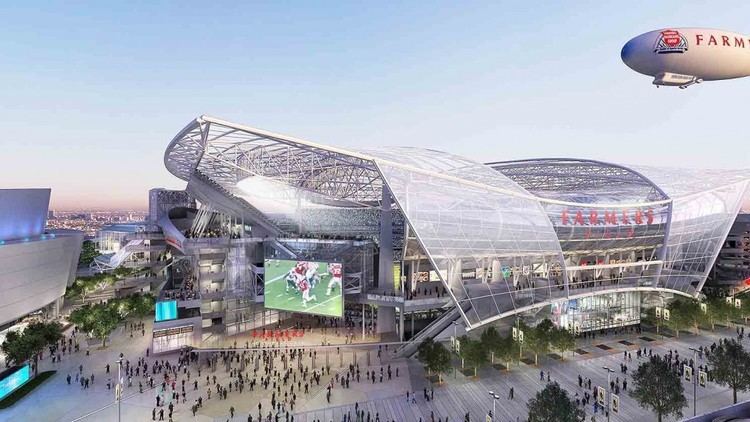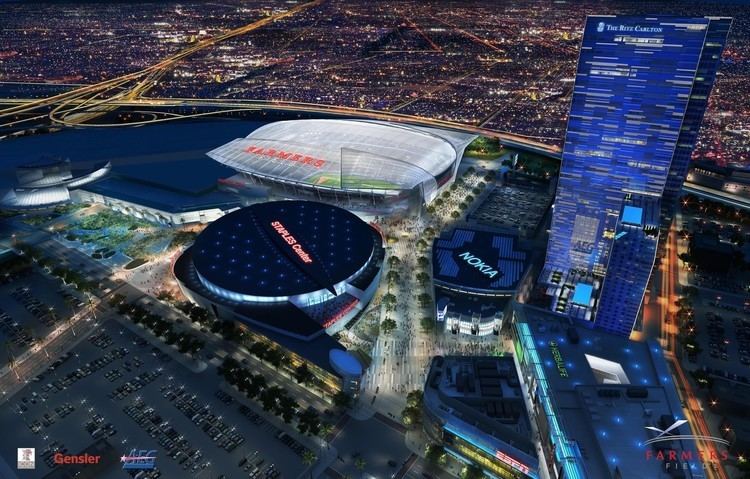Coordinates , Architecture firm Gensler | Capacity 72,000 Function Stadium | |
Former names Los Angeles Events Center Location South Figueroa Street
Los Angeles, California Construction cost US$1.2 billion (estimated) Owner Anschutz Entertainment Group Similar Los Angeles Stadium, Los Angeles Stadium, Los Angeles Conventi, LA Live, Staples Center | ||
Farmersfield com welcome to farmers field
Farmers Field was a proposed sports and events stadium in Downtown Los Angeles, California, United States, at the current site of the West Hall of the Los Angeles Convention Center, adjacent to Staples Center.
Contents
- Farmersfield com welcome to farmers field
- Farmers field at l a live to bring nfl to los angeles
- History
- Legal challenge and settlement
- References

The project was spearheaded in 2010 by outgoing Anschutz Entertainment Group (AEG) president Tim Leiweke and former Los Angeles Avengers owner Casey Wasserman. The project marked AEG's second attempt at building a stadium there following a similar proposal in 2002. The Los Angeles City Council approved the project in a 12-0 vote in 2012, with the hope of the region fielding an NFL team for the first time since the Rams and Raiders left the Los Angeles area.
AEG abandoned the project in March 2015, after the Oakland Raiders, the San Diego Chargers, and the St. Louis Rams (the three most likely candidates for relocation) all proposed their own stadium plans in the event they were to relocate to Los Angeles. Farmers Insurance owned the potential naming rights to the stadium.

Various other proposals have been made for stadiums in Los Angeles, including the Carson Stadium in Carson, the Los Angeles Stadium in Industry and the eventual City of Champions Stadium in Inglewood. The Inglewood proposal and the Rams move was approved 30-2.

Farmers field at l a live to bring nfl to los angeles
History

At the time of the proposal, the Los Angeles metropolitan area—the second largest in the United States—had no National Football League team, although it had hosted three in the past and had at least two teams in each of the other major professional sports leagues in the United States and Canada.

ICON Venue Group, a firm in the sports and entertainment industry, was hired by AEG to represent them in the entitlement process with the city of Los Angeles in February 2011. ICON had originally partnered with AEG in 2002 for AEG's first stadium proposal attempt. That project was to be located on the same site of AEG's current proposal. The new proposal was that the West Hall of the Los Angeles Convention Center would be torn down and rebuilt further south at a cost of US$350 million. Following the completion of the rebuilt West Hall, construction of a 72,000-seat retractable roof stadium would have begun over the 15 acre site. AEG expected to begin construction of the stadium by March 2013 and be completed by late 2016. Though the stadium itself was to be financed by AEG, the company proposed that the cost of the rebuilt West Hall of the convention center be funded by city issued bonds, which would have been repaid by taxes assessed on events in the proposed stadium as well as rent paid by AEG for using the land the stadium would have been on. The proposed stadium was suggested as a possible venue for future Super Bowls and NCAA Men's Division I Basketball Championships. In December 2010, Magic Johnson announced his partnership with AEG's proposal after selling his minority stake in the Los Angeles Lakers NBA team and multiple Starbucks coffeehouse locations.
The project announced in mid-2010 was initially projected at a cost of $750 million. The feasibility of constructing a 72,000-seat (expandable to 76,000 seats for special events such as the Super Bowl) retractable roof stadium at the announced cost came into question when compared to the two newest facilities of the NFL, AT&T Stadium and MetLife Stadium, which were built at a cost of US$1.3 and US$1.6 billion, respectively. Shortly thereafter, Leiweke set a formal timeline for the proposed project. The project's estimated total cost was US$1.2 billion as of 2011.
On February 1, 2011, Farmers Insurance Group announced it had signed a 30-year, $700 million naming rights deal for the stadium, with the stadium to be called Farmers Field. The deal was potentially worth $1 billion if two NFL teams relocated to Farmers Field.
In a February 2011, Farmers emphasized that its naming rights agreement would be spread out over 30 years and that it could walk away from the deal if the Los Angeles stadium wasn't completed. “While we have every confidence that this project will get done, if it does not materialize, Farmers Insurance will pay no money for the project,” said Mark Toohey, senior vice president at Farmers.
In a blog post published on February 15, 2011 in relation to the Collective Bargaining Agreement negotiations with the NFL Player's Association, NFL Commissioner Roger Goodell expressed a desire to return the NFL to Los Angeles. He named Los Angeles first in listing cities that needed new NFL stadiums. He wrote, “The status quo means failing to recognize the many costs of financing, building, maintaining and operating stadiums. We need new stadiums in Los Angeles, Minneapolis, San Francisco, Oakland and San Diego.”
On March 25, 2011, Gensler was selected by AEG to design the proposed football stadium. Five teams; the Minnesota Vikings, San Diego Chargers, St. Louis Rams, Jacksonville Jaguars and Oakland Raiders were speculated as candidates for relocation. The Vikings were the front-runners until they were taken out of consideration after the Minnesota State Senate approved a financing package that would allow the team to build a new stadium in the state of Minnesota by 2016.
The Los Angeles City Council approved the project in a 12-0 vote on September 28, 2012. The building of the stadium was contingent on reaching a deal with the NFL and a team agreeing to move to Los Angeles. Teams were allowed to begin applying to make that move beginning January 1, 2013.
With the departure of Leiweke from AEG, it became less likely that AEG will participate in the construction of Farmers Field. By May 2014, the prospects for a downtown stadium had diminished to such a degree that a committee of the Los Angeles City Council voted to move forward with alternative plans to expand the Convention Center without the stadium.
On March 9, 2015, AEG announced that it would not seek an extension for its April 17 deadline to reach an agreement with an NFL team, effectively shutting down the proposal. The St. Louis Rams had reached an agreement with Inglewood, California to build an 80,000 seat stadium two weeks earlier, while the Oakland Raiders and the San Diego Chargers had expected their joint stadium bid to be approved by Carson, California in the coming months, eliminating the need for a third party to build a stadium. AEG had invested over $50 million in the project over five years.
Legal challenge and settlement
In 2009, AEG pushed for a state law that limited potential legal challenges against the stadium to a 175-day period. A coalition of anti-poverty groups, including Los Angeles Community Action Network (LA CAN), opposed the construction of the stadium in its proposed location, due to the negative effect it was perceived to have on health, traffic, noise, and affordable housing.
In a settlement announced November 1, 2012, the coalition, called Play Fair at Farmers Field, secured "$50 million in concessions... including $10.3 million for a new platform at a Metro Blue Line station and $8 million in upgrades to a plaza outside the Convention Center."
